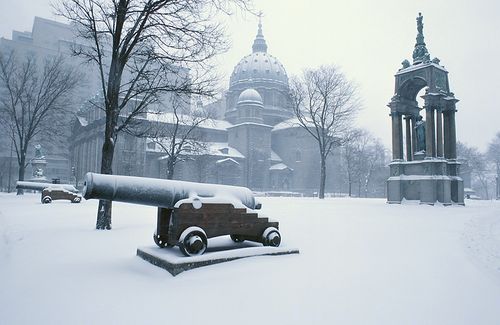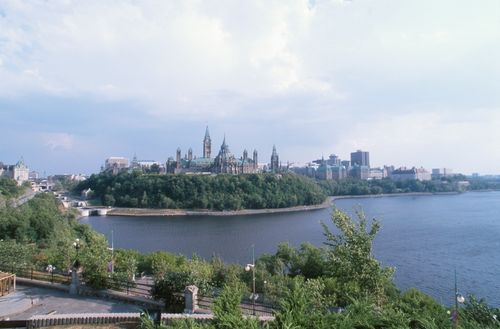|
|
Canada is a land of exhilarating opportunities. The first thing that comes into mind when you think of this northern most North American country is the artistic maple leaves and the trotting of the Royal Canadian Mounted Police. Beyond this, Canada is a modern and prosperous economy with a treasure trove of natural splendours. It is the largest country in the world only being second to Russia. The United States of America provides the only land border to Canada. All the other sides are hit by waves of the Atlantic Ocean, the Pacific Ocean and the Arctic Ocean. The Banks Island, Victoria Island, Baffin Island and Ellesmere Island and regions of the Arctic saline waters come under the jurisdiction of Canada. Ottawa is the capital city of the country and centre of administrative activities. Other important cities include Calgary, Edmonton, Montreal, Toronto, Vancouver and Winnipeg.
 Niagara Falls
Niagara Falls
|
Aboriginal tribes inhabited Canada nearly ten thousand years ago until their existence was threatened by the British and French settlers in early fifteenth century. Today, about 40% of the Canadian population are of British descent, while 27% are of French origin. The native tribes are a minority now. During the last decade of the twentieth century, Canada had the highest immigration rate than any country in the world. Presently, it has become a haven for tourists with paramount natural beauty spread all over the country. About 45% of the people are Roman Catholics, while some 40% are Protestant. English and French are the official languages, and federal documents are published in both languages.
 Canadian Rockies
Canadian Rockies
|
Geography
Canada is one of the northern most political identities of the world. Situated on the upper half of the North American continent, the country possesses an impressive coastline and a huge collection of islands and fjords. Canada shares its only land border with the United States of America on south and its sea borders are the Pacific Ocean to the west, the Atlantic Ocean on the east and the Arctic Ocean in the north. Covering most of the northern part of the North American continent and with an area larger than that of the United States, Canada has an extremely varied topography. The landscape consists of mainly of plains, with mountains in the west, lowlands in the southeast and far spread forest areas.
The eastern coastlines of Hudson Bay and the Gulf of St. Lawrence create a rugged borderline and extend along the west coast. The fertile and cultivable areas are spread over most of southern Quebec and Ontario, the interiors of southern Manitoba and Saskatchewan and most of Alberta. Westward toward the Pacific, the coast range is ragged with fjords and channels. The general terrain here is largely covered by parallel mountain ranges, including the Rockies. Canada is home to one tenth of the world's forests and has the largest reserve of natural fresh water. The mainland is dotted with numerous lakes. They include part of the Great Lakes, which are Erie, Huron, Ontario and Superior. The Great Bear, the Great Slave Lake, Lake Athabasca and Lake Winnipeg are entirely situated in Canada. The two principal rivers of the country are the Mackenzie and the St. Lawrence. The highest point in Canada is Mount Logan (19,850 ft; 6,050 m), which is in the Yukon.
 Bow River
Bow River
|
Climate
Canada's climate is influenced by it changes in latitude and varied topography. The weather conditions tend to be temperate down south near the border area with United States. Although a journey towards the northern regions brings in sub-arctic and arctic climate. In winters, the terrains are often lashed with rains and the temperature in some regions can dip as low as -50°C (-58°F). Hot summers are experienced in southern Canada with an average temperature of 20 °C.
 Mary Queen of the World Cathedral in Montreal
Mary Queen of the World Cathedral in Montreal
|
History
Canada is one of those countries in the world that at one point of time was the colonial base of both the British and French rulers. Starting from fifteenth century, the infamous French-English rivalry over domination on Canada went on until 1763. On other side, evidences found in L'Anse aux Meadows of Newfoundland suggest that the Vikings were early seafarers who visited Canada. However, prior to the arrival of the foreigners in Canada, various indigenous peoples, namely, the First People, the Inuit, the Dene and a tribe from Yukon region, inhabited the area. A constructed piece of Canadian history is available from the time when John Cabot, an Italian in the service of Henry VII of England, reached Newfoundland or Nova Scotia in 1497. The French connection with Canada took place in 1534 after Jacques Cartier landed on the shores and claimed an area of the St Lawrence River for France.
However, colonists did not arrive until Samuel de Champlain founded the first French colony in Quebec. Later, in 1583, Newfoundland became Britain's first overseas colony on efforts of Sir Humphrey Gilbert. The expansion of British and French colony areas continued for next few decades. France's colonisation efforts were sparse compared to the British but by the end of the 17th century, they gradually moved beyond the Great Lakes to the western prairies and south along the Mississippi to the Gulf of Mexico. In 1670, a group of London merchants formed the Hudson's Bay Company and consolidated Britain’s stand in Canada.
Rivalry between the British and the French continued and in 1763 the British defeated the French in the Seven Years' War. With the signing of the Treaty of Paris, Canada was ceded to Britain but the French-speaking colonists preserved their way of life through the Quebec Act of 1774 that protected the use the French language, educational rights and civil law. In next few years, thousands of British colonists immigrated to Canada from the UK, Ireland and other European countries. After years of revolution, the right of Canada to self-government was recognized in 1849. The British North America Act of 1867 created the dominion of Canada created through the confederation of Upper and Lower Canada, Nova Scotia, and New Brunswick. Manitoba joined the Canadian federation in 1870, followed by British Columbia in 1871, Prince Edward Island in 1872, Alberta and Saskatchewan in 1905 and Newfoundland in 1949. During both the World Wars, Canada supported Britain all through. Canada became an independent country in 1931 but remained a constitutional monarchy with the British monarch as head of state. Reforms took place in 1982 and Canada was granted the right to adopt its own Constitution.
 Toronto Skyline
Toronto Skyline
|
Economy
Canada’s economy is one of the pioneers in foreign trade. Long removed from an economy based almost exclusively on natural resources, Canada is rapidly moving towards an export-oriented economy built on free market policies. Canadian businesses are ‘getting connected’ more than ever before, exploiting high-end technologies to reach out into the global marketplace in search of buyers for their products. The success of the moves are evident from the figures, which display that exports account for roughly a third of GDP and a healthy level of trade surplus.
The financial upheaval is further aggravated by signing of the US-Canada Free Trade Agreement (FTA) and the 1994 North American Free Trade Agreement (NAFTA). The United States is by far Canada's leading trade partner, followed by Japan and Great Britain. Though, nowadays, the country is trying to get rid off it’s over dependency on trade with United States. Canada has reversed its weak points to build them as the strong pillars of economy. The population count of the country is low but the total work force is highly skilled and adaptable to changes in information technology. Similarly a high-tech industrial society and profitable agricultural measures compensate for the deficit of arable land in the country. Tourism and financial services represent some of Canada's most important industries within the service sector. However, manufacturing remains Canada's single most important economic activity. High tax rates, staggering population count and domestic disputes are the issues of concern in the current Canadian economy.
 Parliament Hill in Ottawa
Parliament Hill in Ottawa
|
Politics
Canada’s political system, as conceived by the Fathers of Confederation in 1867, has evolved as an independent parliamentary monarchy over the period of time. Today it is a vibrant global example of democracy in action. The system is based on the constitutional document titled Canada Act of 1982, which replaced the British North America Act of 1867 and gave Canada the right to amend its own constitution. The Constitution authorises the parliament to make laws in certain areas of jurisdiction, such as criminal law, defence, international trade and broadcasting. It also delegates authorities to different branches of power and set the limitation of their roles.
Canada’s executive body consists of three parts that are the Queen as Head of State, represented by the Governor General, the appointed Senate, and the elected House of Commons. The Governor General performs ceremonial duties like calling Parliament together after every general election, reading the Speech from the Throne outlining the government’s objectives and passing the Royal assent to all bills passed by the Senate and the House of Commons. The prime minister of the country is usually the leader of the majority party in the parliament and is appointed by the Governor General. The premier together with his set of cabinet ministers, whom he nominates, constitutes the Privy Council of Canada that works on behalf of the crown.
The legislative body of Canada is made up of The Senate and The House of Commons, just in line with the British parliament. The Senate also known as the Upper or Red Chamber has 105 members. Senators are appointed by the Governor General on the advice of the prime minister to represent regions, provinces or territories. Senators can serve until the age of 75.The House of Commons has strength of 301 members, who are elected through nationwide votes. Senators and Commoners both study debate and often amend legislative proposals or “bills.”
The judiciary of the country comprises of the Supreme Court of Canada, the Federal Court of Canada, the Federal Court of Appeal and several Provincial Courts. The judges are appointed by the prime minister through the governor general.
Administratively, Canada is a federation of ten provinces that are Alberta, British Columbia, Manitoba, New Brunswick, Newfoundland and Labrador, Nova Scotia, Ontario, Prince Edward Island, Quebec, and Saskatchewan. The three territories of the country are Northwest Territories, Yukon and Nunavut.
 Waterton Lake
Waterton Lake
|
|
|

